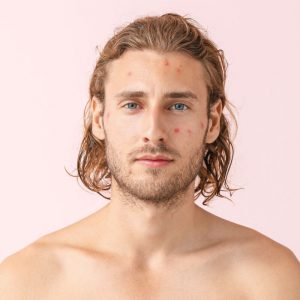Welcher Hauttyp bin ich?
Welcher Hauttyp bin ich?
Deinen Hauttypen zu kennen ist besonders wichtig, um die perfekte Pflege zu finden. Das kann unter Umständen allerdings schwierig sein, besonders dann, wenn sich die Haut nicht einem Hauttypen zuordnen lassen kann. Bei vielen Menschen ändert sich das Erscheinungsbild der Haut auch im Laufe des Jahres und ist abhängig von der Jahreszeit und anderen äußeren Faktoren.
Aber keine Sorge – wir helfen dir, deinen Hauttypen zu bestimmen und das perfekte Pflegeprodukt für dich zu finden.

Die verschiedenen Hauttypen und die perfekte Pflege
Es gibt insgesamt 4 verschiedene Hauttypen: normale Haut, fettige Haut, trockene Haut und Mischhaut. Wie sich die verschiedenen Hauttypen unterscheiden und wie du diese optimal pflegst, erklären wir dir jetzt. Wenn du danach immer noch nicht weißt, welcher Hauttyp du bist, kannst du im Anschluss noch mit unserem Selbsttest herausfinden, welcher Hauttyp du bist.

Fettige Haut
So erkennst du fettige Haut
Glänzt deine Haut und sieht ölig aus, auch ohne Pflege? Neigt deine Haut zu Unreinheiten, wie zum Beispiel Pickel oder Mitesser? Hast du große Poren? Wenn du alle diese Fragen mit Ja beantworten konntest, hast du höchstwahrscheinlich eine fettige Haut.
Bei einer fettigen Haut wird besonders viel Talg produziert, was dazu führt, dass die Haut glänzt. Hierfür kann es verschiedene Auslöser geben. Viele Menschen sind genetisch zu fettiger Haut veranlagt. Aber auch Medikamente, Stress oder Hormonveränderungen können Ursache für die fettige Haut sein. In einigen Fällen wird die fettige Haut auch durch bestimmte Kosmetika ausgelöst.
Die perfekte Pflege für fettige Haut
Deine Haut ist ölig und glänzt? Dann spielt für dich die Reinigung eine besonders große Rolle. Du solltest deine Haut am besten morgens und abends mit einem Waschgel waschen. Probiere dazu gerne mal unser Tonerde Waschgel – dieses sorgt mithilfe der Tonerde für eine porentiefe Reinigung deiner Haut. So wird Schmutz und überschüssiger Talg entfernt und Mitessern und Pickeln vorgebeugt.
Mehr über die Pflege bei fettiger Haut erfährt du hier: Gesichtspflege für Männer mit fettiger Haut Bei einer fettigen Haut wird besonders viel Talg produziert, was dazu führt, dass die Haut glänzt. Hierfür kann es verschiedene Auslöser geben. Viele Menschen sind genetisch zu fettiger Haut veranlagt. Aber auch Medikamente, Stress oder Hormonveränderungen können Ursache für die fettige Haut sein. In einigen Fällen wird die fettige Haut auch durch bestimmte Kosmetika ausgelöst.
Normale Haut
Deine Haut ist glatt mit feinen Poren? Du hast ein mattes Hautbild und keine fettigen oder trockenen Stellen? Dann hast du vermutlich normale Haut. Das bedeutet, dass der Feuchtigkeitshaushalt, die Talgproduktion und die Durchblutung der Haut ausgeglichen sind. Zudem neigt normale Haut nicht zu Unreinheiten und zu keinen besonderen Empfindlichkeiten.
Die richtige Pflege für normale Haut?
Wenn du normale Haut hast, leidest du an keinen Empfindlichkeiten und deine Haut sieht immer frisch aus. Um deine gesunde Haut auch weiterhin so beizubehalten, ist die richtige Pflege essentiell. Die falschen Pflegeprodukte können hier einen großen Schaden anrichten. Daher setze am besten auf Naturkosmetikprodukte. So gehst du sicher, dass kein Mikroplastik, Parabene, Silikone und andere schädliche Stoffe in deinen Produkten sind.
Am besten eignet sich eine Feuchtigkeitscreme, wie eine Gesichtscreme mit Mandelöl und Hanföl. Die Creme zieht super schnell ein und schützt deine Haut vor äußeren Einflüssen, wie UV-Strahlung, Heizungsluft und Co.
Trockene Haut
Trockene Haut ist meistens leicht zu erkennen. Die Haut juckt und spannt, vor allem nach dem Waschen. Zudem sieht sie rau und schuppig aus und reagiert schnell auf Temperaturschwankungen und Heizungsluft. Häufig haben Menschen mit trockener Haut auch immer wieder gerötete Stellen im Gesicht.
Bei trockener Haut wird weniger Talg produziert, als bei anderen Hauttypen. Je nachdem, wie wenig Talg produziert wird, wird bei trockener Haut auch noch einmal zwischen “etwas trockener”, “sehr trocken” und “extrem trocken” unterschieden. Durch die verminderte Talgproduktion besteht ein Mangel an Lipiden. Diese sollen einen Feuchtigkeitsverlust verhindern und einen Schutzfilm bilden, der die Haut vor äußeren Einflüssen schützen kann.
Die Ursachen für trockene Haut sind der Feuchtigkeitsverlust der Haut. Dies kann einerseits über die Schweißdrüsen, wie zum Beispiel durch Wärme oder Sport, passieren, aber auch passiv, indem Wasser über die Hautschichten verdunstet. Dies ist in Maßen normal, allerdings mangelt es trockener Haut an natürlichen Feuchthaltefaktoren sowie an einer gesunden Hautbarriere.
Mischhaut
Mischhaut zeichnet sich durch verschiedene Merkmale aus und vereint einige Eigenschaften von fettiger bzw. unreiner Haut mit Eigenschaften von normaler bzw. trockener Haut. Die meisten Menschen mit einer Mischhaut haben fettige Haut in der T-Zone und normale bzw. trockene Haut auf den Wangen. Die T-Zone meint den Bereich Stirn, Nase und Kinn. Dabei kann es sich um sehr schmale Streifen auf den jeweiligen Teilen des Gesichtes handeln oder auch um breitere.
Ursachen für die Mischhaut sind übermäßige Talgproduktion in den betroffenen Stellen der T-Zone und weniger Talgproduktion an den Wangen.
Welche Creme bei fettiger T-Zone?
Du hast eine Mischhaut und weißt nicht, welche die richtige Pflege für dich ist? Aufgrund deiner fettigen T-Zone solltest du vor allem auf eine regelmäßige Reinigung der Haut achten. Dies solltest du sowohl morgens als auch abends machen. Ein Waschgel in Kombination mit einer leichten Feuchtigkeitscreme, die sich für alle Hauttypen eignet, ist die perfekte Lösung für dich.
In unserer Gesichtspflege Box haben wir alle Produkte, die du brauchst, vereint. Mithilfe von deinem neuen Waschgel kannst du deine Haut porentief von Schmutz befreien. Auch eine Hautcreme, die für alle Hauttypen geeignet ist, ist dabei. Diese kannst du immer nach der Reinigung auftragen, um deine Haut optimal mit Feuchtigkeit zu versorgen.
Test: Welcher Hauttyp bin ich?
Du bist dir unsicher, welchen Hauttyp du hast? Keine Sorge: Die folgenden Fragen können dir sicher helfen, deine Haut besser kennenzulernen.
Um den Test durchführen zu können, solltest du zunächst dein Gesicht waschen und danach NICHT eincremen. Warte etwa 15 Minuten und beantworte dann die erste Frage aus unserem Selbsttest:

1. Wie fühlt sich deine Haut kurz nach dem Waschen an?
Meine Haut…
➔ ist erfrischt und sauber. Nur kurz nach der Reinigung hast du das Gefühl, dass deine Haut wirklich sauber ist, aber schon wenige Zeit später merkst du, dass deine Haut langsam wieder ölig wird? Das ist ein Zeichen für fettige Haut.
➔ fühlt sich normal und sauber an. Bei deiner Haut handelt es sich wahrscheinlich um normale Haut.
➔ spannt oder schuppt. Dann ist dies ein Zeichen für trockene Haut. Deine Haut ist nicht ausreichend mit Feuchtigkeit versorgt.
➔ weder noch. In der T-Zone hast du ein erfrischendes Gefühl, aber auf den Wangen spannt die Haut und fühlt sich rau und schuppig an? All das sind Anzeichen für eine Mischhaut.
2. Siehe deine Haut im Spiegel an.
Hast du Rötungen? Hast du Pickel oder Mitesser?
➔ Ich habe unreine Haut, die mit einem öligen Glanz überzogen ist. Das sind Anzeichen für eine fettige Haut. Menschen mit diesem Hauttypen haben häufig verstopfte Poren und in einigen Fällen auch Akne.
➔ Ich habe keine Rötungen, Pickel oder Mitesser. Wenn dies deine Antwort ist, deutet alles auf eine normale Haut hin. Deine Haut ist weder trocken noch glänzt sie.
➔ Ich habe einige Rötungen. Meine Haut sieht fahl und schuppig aus. Dies sind Anzeichen für eine trockene Haut.
➔ Meine Haut sieht an den Wangen fahl aus und glänzt in der T-Zone. Dies weist auf eine Mischhaut hin.
3. Schau dir deine Poren genauer an. Wie würdest du die Größe deiner Poren beschreiben?
➔ Ich habe große Poren. Dies ist besonders bei fettiger Haut der Fall. Die Poren verstopfen schnell und weiten sich dadurch weiter aus.
➔ Meine Poren sind kaum bis gar nicht zu sehen. Das ist vor allem bei Menschen mit normaler Haut der Fall.
➔ Meine Poren sind sehr klein, aber neigen dazu zu spannen. Dann hast du wahrscheinlich trockene Haut.
➔ Ich habe in meiner T-Zone große und verstopfte Poren, im Rest des Gesichtes sind meine Poren kaum sichtbar. Dies sind deutliche Anzeichen für eine Mischhaut.
Habe ich empfindliche Haut?
Empfindliche Haut kann jede Person betreffen, unabhängig vom Hauttyp. Betroffene leiden meistens an Gefühlen, wie Spannen, Kribbeln, Juckreiz oder Brennen der Haut. In einigen Fällen ist die Haut auch trocken oder gerötet. Treffen diese Symptome auf dich zu, ist es gut möglich, dass du empfindliche Haut hast.
Die Ursachen für empfindliche Haut sind sehr vielfältig.
Die Hautbarriere ist in den meisten Fällen geschwächt und die Nervenenden sind besonders empfindlich. Aus diesem Grund senden diese Schmerzsignale auf eigentlich harmlose Reize. Auch äußere Ursachen können für empfindliche Haut verantwortlich sein. In vielen Fällen sind Temperaturschwankungen der Grund. Auch Wind und Sonne können die Empfindlichkeit der Haut beeinflussen. Ein weiterer Grund können ungeeignete Kosmetika oder Waschmittel sein. Auch die Aufnahme von verschiedenen Lebensmitteln und Getränken kann zu einer Empfindlichkeit der Haut führen. Dazu gehören insbesondere scharfes Essen sowie Alkohol. Auch hormonelle Veränderungen oder Stress können sich auf die Haut auswirken. Zudem leiden Menschen mit einer Glutenunverträglichkeit auch häufig an einer empfindlichen Haut.
Sharing is caring!
Und, welcher Hauttyp bist du?
Wir freuen uns, von dir auf Instagram oder Facebook zu hören.










